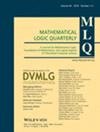The Hartogs–Lindenbaum spectrum of symmetric extensions
IF 0.4
4区 数学
Q4 LOGIC
引用次数: 0
Abstract
We expand the classic result that is equivalent to the statement “For all , ” by proving the equivalence of many more related statements. Then, we introduce the Hartogs–Lindenbaum spectrum of a model of , and inspect the structure of these spectra in models that are obtained by a symmetric extension of a model of . We prove that all such spectra fall into a very rigid pattern.
对称扩展的哈托格-林登鲍姆谱
我们通过证明更多相关陈述的等价性,扩展了等价于 "对于所有Ⅳ"陈述的经典结果。然后,我们引入了Ⅳ模型的哈托格斯-林登鲍姆谱,并考察了通过Ⅳ模型的对称扩展得到的模型中这些谱的结构。 我们证明,所有这些谱都属于一种非常严格的模式。
本文章由计算机程序翻译,如有差异,请以英文原文为准。
求助全文
约1分钟内获得全文
求助全文
来源期刊
CiteScore
0.60
自引率
0.00%
发文量
49
审稿时长
>12 weeks
期刊介绍:
Mathematical Logic Quarterly publishes original contributions on mathematical logic and foundations of mathematics and related areas, such as general logic, model theory, recursion theory, set theory, proof theory and constructive mathematics, algebraic logic, nonstandard models, and logical aspects of theoretical computer science.

 求助内容:
求助内容: 应助结果提醒方式:
应助结果提醒方式:


